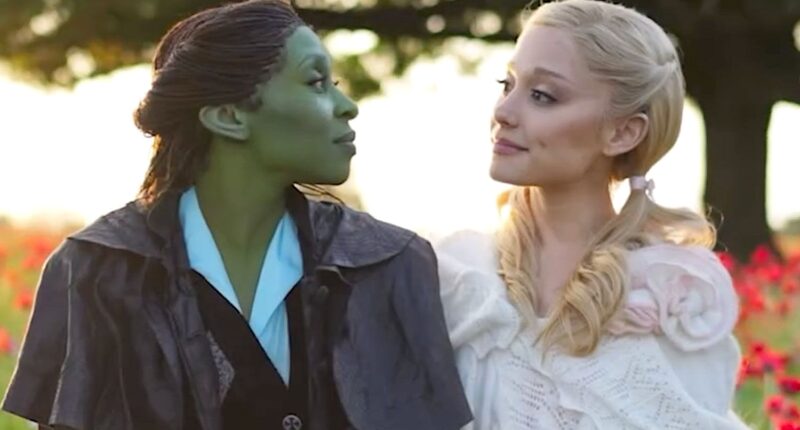Wicked: For Good thus opens a bit like a superhero flick with the now rebellious Elphaba performing outlaw acts of heroism by attacking the Wizard of Oz’s minions as they force enslaved animal labor to build his precious Yellow Brick Road. During the sequence, we get truncated reprises of “No One Mourns the Wicked.” Afterward the lyrics of “What Is This Feeling?” and a few bars of “Popular” are rewritten and recontextualized for sequel table-setting exposition as we are reintroduced to Glinda; these days she has passively agreed to become “the Good Witch” face of propaganda for the Wizard of Oz (Jeff Goldblum). The bits of the old songs are useful in reminding audiences where we left off with these characters a year ago, although one cannot help but feel the cynicism of reminding customers of the music and even dance choreography that captured their hearts in minds in another, better film.
It sets the stage for both the virtues and vulnerabilities of Wicked: For Good writ large. This is still a movie with the same charming cast, the same stunning production design of art deco green and pink by Nathan Crowley, and definitely much of the same music. But to justify the shorter (and frankly always worse) second act of the musical getting its own film, the narrative, character beats, and that glorious music is uniformly padded out as we stroll instead of run toward the general thrust of Wicked’s climax: Elphie and Glinda are divided by the green one’s devotion to the truth and doing what is right versus Glinda’s fondness for what is safe and comfortable.
Between that central conflict lies a few other narrative strands, including the evolving loyalties of the dashing Fiyero (Jonathan Bailey), now promoted to Captain of the Guards, as well as Elphie’s disabled sister Nessa (Marissa Bode) and the sinister Madame Morrible (Michelle Yeoh), essentially an Ozian Joseph Goebbels. Any and all will face a reckoning when a gal named Dorothy comes to town. Still, in its heart of hearts, this is a two-hander about two powerhouse performances which can find great harmony whenever Wicked: For Good swings back around to the better musical numbers written nearly 25 years ago for the stage.
Indeed, the titular “For Good,” a final duet between the leads, is a heartfelt weepy that speaks to the mysteries of true, transformative friendship that to this day leaves young theatergoers bawling. Sometimes their parents too. Grande also gets an excellent solo in “Thank Goodness.” it is not nearly as bubbly or tourist-friendly as “Popular,” but it reveals newfound dimensionality to Grande’s performance of Glinda, which in the sequel exceeds the stage show’s interest in exploring and judging her complicity in Oz’s cruel regime. Similarly, newly added lyrics to the Wizard’s “Wonderful,” an old-timey Vaudeville number for Goldblum’s carnie-turned-despot, feel deliberately updated for a modern world where the threat of encroaching corruption and oppression is not so abstract.
When composer and lyricist Stephen Schwartz is simply adding new context to his old songs, as with “Wonderful,” the effect can be grand. In addition to making the song updated for our modern, orange-hued Oz, tweaks allow for more screen time between Erivo, Grande, and Goldblum—which is probably the highlight of For Good. Yet when Schwartz is writing entirely new songs in order to theoretically beef up a second film, and presumably to give Erivo a big solo since Elphie never quite had one in Act Two, the film runs into a recurring problem: long stretches of stifled momentum and energy, which seem directly proportionate to the need to turn a climactic charge into a dawdle through the poppy field.
Consequently, issues that seemed mildly off-putting in the first Wicked, such as the strange choice to seek a washed out lighting and color palette in locations as vibrant as the Emerald City, become more glaring in the sequel. And the bits that always felt a wee contrived or melodramatic on stage, such as the resolution of Elphie and Nessa’s relationship, are met by new scenes of similar or greater soapiness in Winnie Holzman and Dana Fox’s screenplay.








